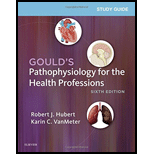
To compare: The Down syndrome and cerebral palsy with regard to cause and effects on motor and cognitive abilities.
Concept introduction: Down’s syndrome is a genetic disorder caused by trisomy of chromosome 21. This results due to a random cell division error. This is known as nondisjunction. Chromosomal errors occur mostly during the formation of gametes; the majority comes from mother in the egg. Three types of chromosomal abnormalities lead to Down’s syndrome—the complete trisomy 21, mosaic trisomy 21, and translocation trisomy 21. A disorder that affect the muscle and coordination is called cerebral palsy. This is caused by brain damage, abnormal feta formation in the functional regions of brain, infection, or genetic mutations in the prenatal period.
Want to see the full answer?
Check out a sample textbook solution
Chapter 14 Solutions
EBK STUDY GUIDE FOR GOULD'S PATHOPHYSIO
- The importance of making a weekly clean list for kitchen staff in a nursing home and how can a nutritionist utilize this in their career? Please not just a short explanation.arrow_forwardThe importance of keeping a clean food pantry in a nursing home and how can a nutritionist utilize this in their career? Please not just a short explanation.arrow_forwardI’m finding it a bit difficult to understand the Arrhenius equation and how shelf life relates to pH and temperature. Also in the question that says ‘this solution maintains 80% potency at 30C’, am I correct in thinking the formula would be:t = ln(0.8)/ -karrow_forward
- 4.24 mmmarrow_forwardResearch videos and websites about mission and vision statements in health care organizations. What did you find most interesting? What did you find to be the most positive-sounding parts of the statements? Were there any mission and vision statements that seemed disconnected from each other or out of alignment with the goals of the organization? If so, how might you change them?arrow_forwardThe Importance of Reviewing Department Budget in a nursing home kitchen and how can a nutritionist utilize this in their career? Please not just a short explanation.arrow_forward
- The Importance of Modify a Standard Food Menu in a nursing home and how can a nutritionist utilize this in their career? Please not just a short explanationarrow_forwardThe Importance of QAPI in a nursing home and how can a nutritionist utilize this in their career? Please not just a short explanation.arrow_forwardProvide a sample scenario of Schizophrenia using a new graduate female engineer patient 1. Title of Simulation Scenario:- Provide a concise title that reflects the focus of the scenario (e.g., "Managing Acute Anxiety in a Young Adult Patient").2. Scenario Overview:- Disorder Focus: Specify the mental health disorder or addictionbeing addressed (e.g., Generalized Anxiety Disorder). - Patient Description: - Age: - Gender: - Background: Briefly describe the patient’s background (e.g., The patient is a 25-year-old female experiencing symptoms of anxiety after starting a new job"). - Current Situation: Detail the patient's current condition and why they are seeking help (e.g., "The patient presents to the ER with chest pain, which has been determined to be a panic attack").- Learning Objectives: - Objective 1: e.g., Demonstrate effective communication techniques for calming an anxious patient. - Objective 2: e.g., Assess and document the patient’s…arrow_forward
- Provide a sample feedback on a nursing student who presented her findings after she interviewed a indigenous coordinator regarding interprofessional collaboration. And include a potential question to ask related to the interviewarrow_forward4. Refer to the oral handover. Explain the care the support worker is providing for Mr Liu.arrow_forwardDO SCHIZOPHRENIA, SPECIFICALY SCHIZOPHRENIFORM 1. Title of Simulation Scenario:• Provide a concise title that reflects the focus of the scenario (e.g., "ManagingAcute Anxiety in a Young Adult Patient").2. Scenario Overview:• Disorder Focus: Specify the mental health disorder or addiction beingaddressed (e.g., Generalized Anxiety Disorder).• Patient Description:o Age:o Gender:o Background: Briefly describe the patient’s background (e.g., "Thepatient is a 25 - year- old female experiencing symptoms of anxietyafter starting a new job").o Current Situation: Detail the patient's current condition and why theyare seeking help (e.g., "The patient presents to the ER with chest pain,which has been determined to be a panic attack").• Learning Objectives:o Objective 1: e.g., Demonstrate effective communication techniques forcalming an anxious patient.o Objective 2: e.g., Assess and document the patient’s mental status.o Objective 3: e.g., Identify approp riate interventions and care planningfor…arrow_forward
 Phlebotomy EssentialsNursingISBN:9781451194524Author:Ruth McCall, Cathee M. Tankersley MT(ASCP)Publisher:JONES+BARTLETT PUBLISHERS, INC.
Phlebotomy EssentialsNursingISBN:9781451194524Author:Ruth McCall, Cathee M. Tankersley MT(ASCP)Publisher:JONES+BARTLETT PUBLISHERS, INC. Gould's Pathophysiology for the Health Profession...NursingISBN:9780323414425Author:Robert J Hubert BSPublisher:Saunders
Gould's Pathophysiology for the Health Profession...NursingISBN:9780323414425Author:Robert J Hubert BSPublisher:Saunders Fundamentals Of NursingNursingISBN:9781496362179Author:Taylor, Carol (carol R.), LYNN, Pamela (pamela Barbara), Bartlett, Jennifer L.Publisher:Wolters Kluwer,
Fundamentals Of NursingNursingISBN:9781496362179Author:Taylor, Carol (carol R.), LYNN, Pamela (pamela Barbara), Bartlett, Jennifer L.Publisher:Wolters Kluwer, Fundamentals of Nursing, 9eNursingISBN:9780323327404Author:Patricia A. Potter RN MSN PhD FAAN, Anne Griffin Perry RN EdD FAAN, Patricia Stockert RN BSN MS PhD, Amy Hall RN BSN MS PhD CNEPublisher:Elsevier Science
Fundamentals of Nursing, 9eNursingISBN:9780323327404Author:Patricia A. Potter RN MSN PhD FAAN, Anne Griffin Perry RN EdD FAAN, Patricia Stockert RN BSN MS PhD, Amy Hall RN BSN MS PhD CNEPublisher:Elsevier Science Study Guide for Gould's Pathophysiology for the H...NursingISBN:9780323414142Author:Hubert BS, Robert J; VanMeter PhD, Karin C.Publisher:Saunders
Study Guide for Gould's Pathophysiology for the H...NursingISBN:9780323414142Author:Hubert BS, Robert J; VanMeter PhD, Karin C.Publisher:Saunders Issues and Ethics in the Helping Professions (Min...NursingISBN:9781337406291Author:Gerald Corey, Marianne Schneider Corey, Cindy CoreyPublisher:Cengage Learning
Issues and Ethics in the Helping Professions (Min...NursingISBN:9781337406291Author:Gerald Corey, Marianne Schneider Corey, Cindy CoreyPublisher:Cengage Learning





